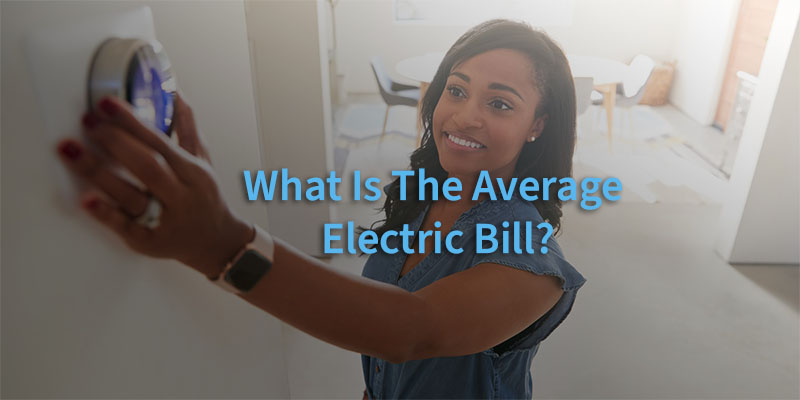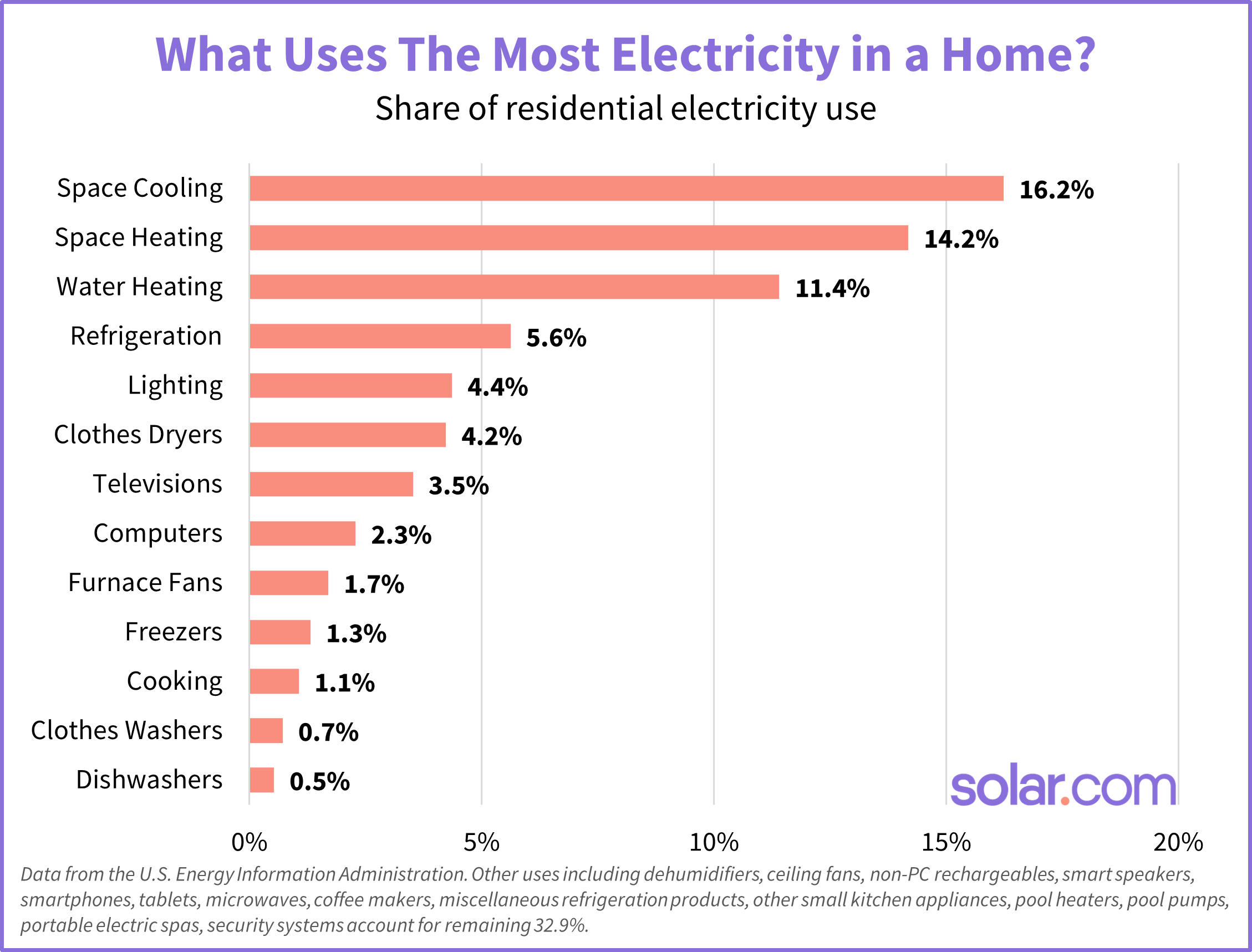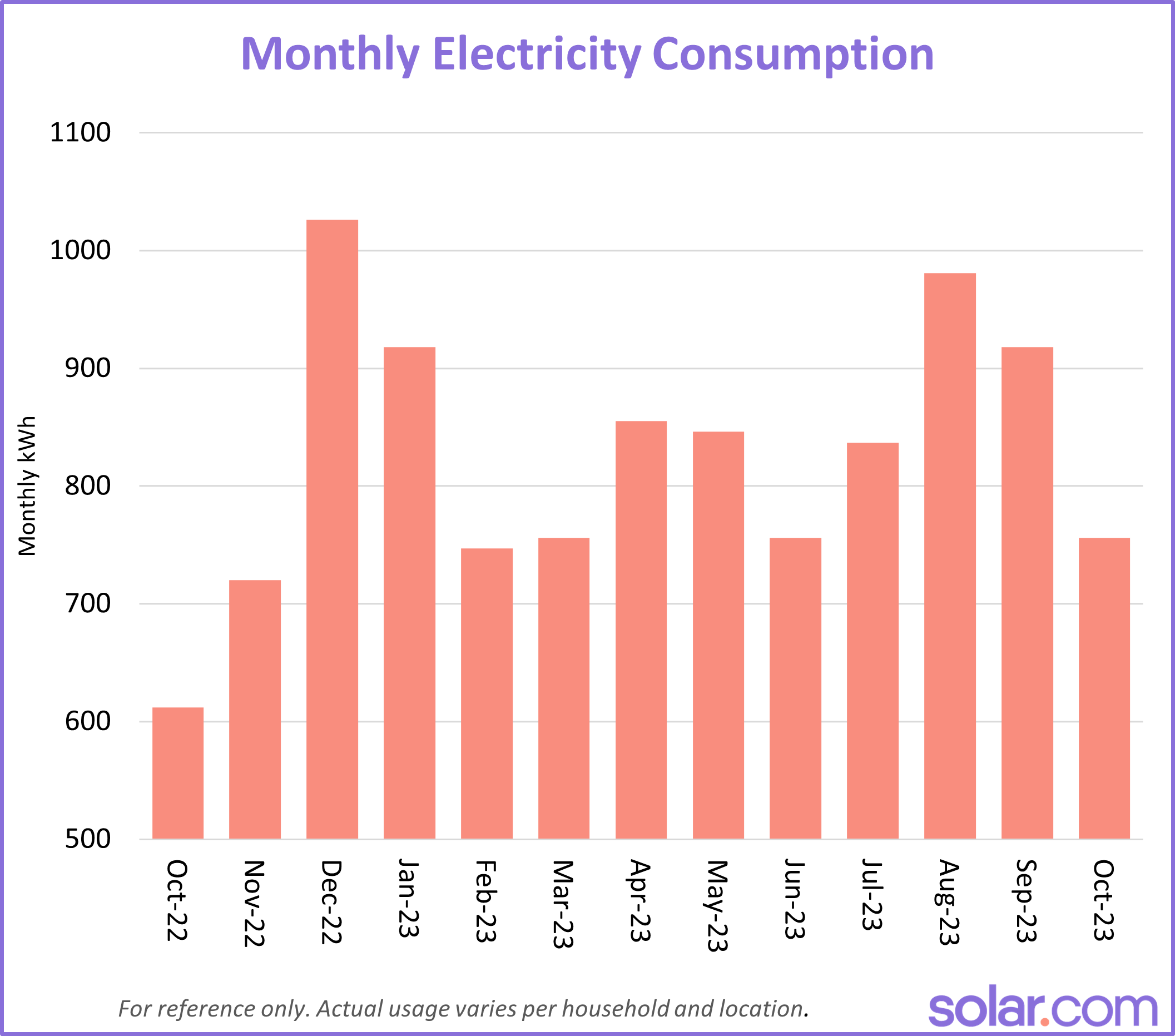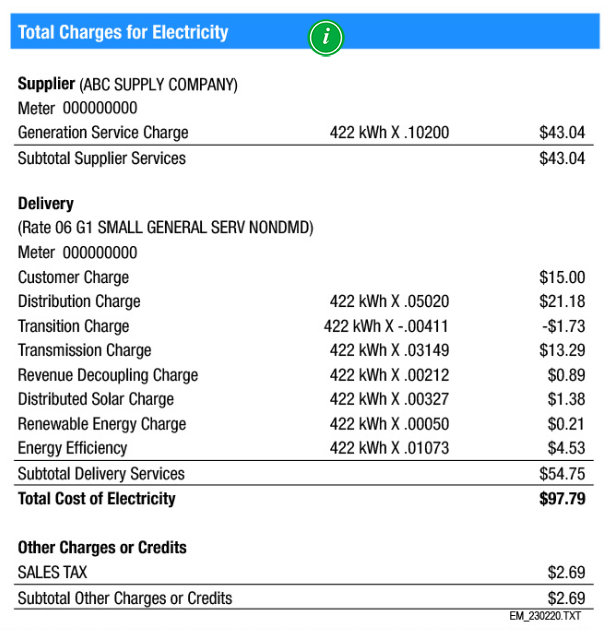
In the 21st century, electricity is an essential cost of living that we’re all going to pay for, one way or another. Yet it’s common for homeowners to feel unsure about whether their electricity costs are high, low, or just right.
Understanding how your average bill compares to the state average is a great first step to answering the question “Why is my electricity bill so high?”
So, in this article, we’ll explore:
- U.S. average electric bill in 2025
- The average electric bill in each state
- How to find your average bill
- How to compare your bill to your state’s average
Let’s start by taking a look at the average electricity bill for each state and the entire US.
U.S. Average Electric Bill in 2025
The average US electric bill in 2025 is $167 per month based on the average residential electricity price of 19 cents per kWh and the average household consumption of 881 kWh per month, based on data from the US Energy Information Administration. This figure does not include fixed basic charges.
Of course, the United States is a large country and a land of extremes, so the national average is more of a landmark than a measuring stick. For example, the average bill in Hawaii ($282) is nearly two and a half times higher than the average bill in Utah ($95).
Why is such a wide range? Well, electricity costs are a combination of usage and rates, both of which vary greatly from state to state.
Related reading: What Is the Average Monthly Electric Bill With Solar Panels?
Average US electricity rate in 2025
The price of electricity in the US ranges from 12 cents to over 40 cents per kWh based on the availability of energy resources, demand, and—quite frankly— politics. In June 2025, the average electric rate in the US reached an all-time high of 19 cents per kWh.
| State | Average Residential Electricity Rate (cents/kWh) |
| Alabama | 16.76 |
| Alaska | 25.96 |
| Arizona | 15.73 |
| Arkansas | 13.61 |
| California | 31.77 |
| Colorado | 15.61 |
| Connecticut | 32.28 |
| Delaware | 17.96 |
| District of Columbia | 21.32 |
| Florida | 15.27 |
| Georgia | 14.84 |
| Hawaii | 42.44 |
| Idaho | 11.89 |
| Illinois | 18.32 |
| Indiana | 17.01 |
| Iowa | 13.41 |
| Kansas | 14.78 |
| Kentucky | 13.91 |
| Louisiana | 13.46 |
| Maine | 28.11 |
| Maryland | 19.08 |
| Massachusetts | 30.65 |
| Michigan | 19.95 |
| Minnesota | 15.12 |
| Mississippi | 15.05 |
| Missouri | 12.83 |
| Montana | 12.33 |
| Nebraska | 13.1 |
| Nevada | 13.36 |
| New Hampshire | 23.66 |
| New Jersey | 20.16 |
| New Mexico | 14.44 |
| New York | 25.67 |
| North Carolina | 14.48 |
| North Dakota | 11.69 |
| Ohio | 16.34 |
| Oklahoma | 13.3 |
| Oregon | 15.38 |
| Pennsylvania | 18.98 |
| Rhode Island | 28.89 |
| South Carolina | 15.77 |
| South Dakota | 13.37 |
| Tennessee | 14.05 |
| Texas | 15.55 |
| Utah | 12.52 |
| Vermont | 23.2 |
| Virginia | 15.43 |
| Washington | 13.03 |
| West Virginia | 16.04 |
| Wisconsin | 18.27 |
| Wyoming | 13.05 |
Average Monthly Electricity Consumption in the US
Meanwhile, electricity usage depends largely on the weather and average temperatures. In the hot, sticky South, it’s common for households to average well over 1,000 kWh of electricity per month, while more moderate coastal states use less than 600 kWh per month on average.
| State | Average household electricity consumption (kWh/month) |
| Alabama | 1,151 |
| Alaska | 621 |
| Arizona | 1,134 |
| Arkansas | 1,116 |
| California | 540 |
| Colorado | 679 |
| Connecticut | 650 |
| Delaware | 928 |
| District of Columbia | 585 |
| Florida | 1,166 |
| Georgia | 1,106 |
| Hawaii | 665 |
| Idaho | 924 |
| Illinois | 704 |
| Indiana | 970 |
| Iowa | 855 |
| Kansas | 902 |
| Kentucky | 1,111 |
| Louisiana | 1,232 |
| Maine | 587 |
| Maryland | 961 |
| Massachusetts | 603 |
| Michigan | 698 |
| Minnesota | 778 |
| Mississippi | 1,172 |
| Missouri | 999 |
| Montana | 776 |
| Nebraska | 893 |
| Nevada | 925 |
| New Hampshire | 606 |
| New Jersey | 692 |
| New Mexico | 686 |
| New York | 576 |
| North Carolina | 1,042 |
| North Dakota | 987 |
| Ohio | 857 |
| Oklahoma | 1,132 |
| Oregon | 928 |
| Pennsylvania | 854 |
| Rhode Island | 576 |
| South Carolina | 1,127 |
| South Dakota | 898 |
| Tennessee | 1,185 |
| Texas | 1,120 |
| Utah | 760 |
| Vermont | 562 |
| Virginia | 1,078 |
| Washington | 916 |
| West Virginia | 1,122 |
| Wisconsin | 703 |
| Wyoming | 765 |
Average Electric Bill By State in 2025
The map below shows the average electric bill in each state. While these averages can serve as a useful benchmark, it’s important to note that there can be considerable variation within each state, which we’ll discuss below.
Related reading: How To Cut Your Electric Bill by 75 Percent
How many kWh per day is normal?
Electricity consumption is unique to each household based on climate conditions, the size of the home, the number of people in the household, and consumption habits.
In Louisiana, it’s normal to use nearly 1,200 kWh per month while in Hawaii the average is closer to 530 kWh per month. This is largely due to climate control needs based on weather, as heating and air conditioning account for over 30% of household electricity consumption.

With this in mind, the size of your home has a significant impact on electricity consumption. Larger homes typically require more electricity to heat and cool, especially if you’re using a central air system that can’t specifically target certain areas.
The number of people per household can also make an impact. For example, the average electricity bill for a four-person household may be much different than the average electricity bill for a two-person household because there are more people consuming electricity. However, electricity consumption also depends on your appliances and vehicles. A larger household with two EVs and all-electric appliances can easily consume more electricity than a smaller household with gas cars and appliances.
This tremendous variability is why it’s important to focus on your own average electricity usage and costs to use as a baseline for your unique situation.
In any case, high electricity usage isn’t necessarily a bad thing, because electricity is typically cheaper than gasoline to fuel a car and natural gas to power appliances. And, unlike the price of fossil fuels, homeowners can lower the price per kWh of electricity by installing solar panels.
How to Calculate Your Own Average Electric Bill
Now that you have a sense of the average cost of electricity in your state, let’s go over some ways to find your average electricity costs using your utility bill.
First, let’s make sure we’re looking at the right bill. The difference between a gas bill and an electricity bill is that a gas bill measures the consumption of natural gas in therms, while an electricity bill measures the use of electricity in kilowatt-hours (kWh). Both may appear on the same utility bill, but this article pertains only to the electricity portion.
With the correct bill in hand, let’s explore two ways to find your average monthly electricity cost.
Average a year’s worth of electricity bills
If you have access to your previous electricity bills, simply gather together one year’s worth of bills, add up the amounts due, and divide by 12 to get a monthly average.
Pro tip: Subtract out any fixed fees in your bill, if you have them, to get a more accurate comparison to your state average.
The table below shows a year’s worth of monthly electricity bills averaged together.
| Billing month | Bill amount |
| November | $119.52 |
| December | $170.32 |
| January | $152.39 |
| February | $124.00 |
| March | $125.50 |
| April | $141.93 |
| May | $140.44 |
| June | $125.50 |
| July | $138.94 |
| August | $162.85 |
| September | $152.39 |
| October | $125.50 |
| Monthly average | $139.94 |
Why a year’s worth? As we mentioned above, over 30% of electricity usage is due to heating and cooling, which varies throughout the year based on the weather. Averaging a full year of bills controls for seasonality throughout the year.
How can I check my electricity bill balance?
Most utility companies offer online billing services, in which you can log into your account and see previous billing statements.
If that’s not offered or you’re experiencing technical issues, you can dig up paper copies of your bills, provided you saved and filed them. If not, there’s a way to find your average usage and cost using a single electricity bill.
Use a single bill to find your average
If you only have your latest electricity bill handy, you can use the consumption details graph to get a decent estimate of your average bill.
Most electric bills feature a graph that shows the last 13 months of electricity usage. This graph shows how your usage fluctuates throughout the year and how the usage in the current billing period compares to the usage in the same period in the previous year (hence the 13 months of data).
These graphs typically look something like this:

To find your average electric bill, first add up the last 12 months of usage data (in this case, November through October) and divide it by 12.
Quick tip: It’s not easy to get precise usage figures from these graphs, but do your best to get as close as possible.
| Month | Electricity usage (kW) |
| November | 720 |
| December | 1026 |
| January | 918 |
| February | 747 |
| March | 756 |
| April | 855 |
| May | 846 |
| June | 756 |
| July | 837 |
| August | 981 |
| September | 918 |
| October | 756 |
| Total annual usage | 10,116 |
| Monthly Average (total / 12 months) | 843 |
Once you have your average monthly usage, you can multiply it by your electricity rate to get an average monthly bill amount. Of course, it’s not always easy to find your electricity rate.
On most electricity bills (like the example below), the rate is broken up into multiple individual charges and credits. There are two ways to discern your rate from your bill.

Add up each rate
First, you can add together the individual rates for each charge. In the example above, the individual rates add up to $0.1962 per kWh. However, this method can get tricky if you have a time-of-use (TOU) or tiered rate schedule that features multiple rates during a single billing period.
Divide your amount due by your usage
The second way is to take the cost of electricity on your latest bill, subtract the flat fee ($15 in this example), and divide by the usage during the billing period.
($97.79 - $15) / 422 kWh = $0.1962 per kWh
Once you have your rate, multiply it by your average monthly consumption to find your average monthly electric bill. In our example, the average bill would be $165.40 per month.
843 kWh per month x $0.1962 per kWh = $165.40 per month
So now what? You have your own average electric bill and the average monthly bill for your state. What do we do with this information?
Comparing your average electricity costs
The best thing to compare your average electricity bill to is your own future electricity bills. In other words, use your average bill as a measuring stick for your own electricity costs, not your neighbors. This can help you identify spikes in your rate and/or usage.
As we discussed earlier in the article, everybody’s electricity needs are unique, and having a high electricity bill isn’t necessarily a bad thing. For example, if you are charging two EVs at home, your electricity bill is going to skyrocket, even if you are saving a ton of money by not buying gasoline.
Having a high electricity bill isn’t necessarily bad, but having a higher-than-average bill is a red flag. For example, if your average bill is $165 per month and you get a bill for $250, it’s time to investigate what happened. If a high electricity bill can’t be explained by a new electrical system (EV charging, AC unit, heat pump, etc), then it’s typically due to a utility rate hike, and you’ll want to catch it as early as possible so you can explore alternative sources of electricity like home solar.
Electricity burden
If you must compare your average electric bill to something, there is a useful measurement called Electricity Burden that answers the question “Am I paying too much for electricity?”.
Electricity burden is the percentage of your gross household income that is spent on electricity. To find it, simply divide your annual electricity consumption by your gross household income.
Electricity Burden = average annual consumption / gross household income
Based on data from the EIA and the US Census Bureau, the average electricity burden in the US is around 2%. So, a household with $90,000 in gross income should expect to pay around $1,800 for electricity per year, or $150 per month.
The average state electricity burden varies from less than 1% in Utah to over 3% in Nevada and can be significantly higher for low-income households. If your electricity burden creeps up above 5%, then you are definitely paying too much for electricity and it’s time to look into ways to reduce your consumption and/or lower your rate with solar panels.
The bottom line
While humans are nosy little creatures that love to compare ourselves to each other, comparing your average electric bill against the state or national average isn’t always helpful. There are simply too many variables that affect each household’s average bill.
However, it is still worthwhile to know your average electric bill so you can quickly identify outliers. In many cases – especially since 2022 – high electricity bills are due to utility rate hikes. It’s important to identify rate hikes early so you can consider alternatives before you spend months or years overpaying for electricity.
If your average electric bill is higher than you can handle, connect with an Energy Advisor to design a solar system that reduces your electricity costs.



